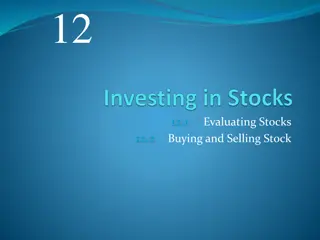Understanding Common Stocks: Analysis & Valuation
Common stock represents ownership in a company, entitling shareholders to assets and earnings. Shareholders have rights such as electing the board of directors and limited liability. Common stocks are valued based on future cash flows. There are two main types of stocks: common and preferred. Valuation methods include efficient market analysis and others.
Download Presentation

Please find below an Image/Link to download the presentation.
The content on the website is provided AS IS for your information and personal use only. It may not be sold, licensed, or shared on other websites without obtaining consent from the author. Download presentation by click this link. If you encounter any issues during the download, it is possible that the publisher has removed the file from their server.
E N D
Presentation Transcript
Unit III: COMMON STOCKS ANALYSIS & VALUATION
1. Meaning of Common Stock: A Stock is a share in the ownership of a company. Stock represents a claim on the company s assets and earnings. Holding a company s stock means that we are one of the many owners of a company and as such we have a claim to everything the company owns.
2) Basic Features of Common Stock: The following are the basic features of Common stock:- 1. As owners of the company, common shareholders have the right to the residual income and assets of the company. 2. Common stockholders are generally the only security holders with the right to elect the board of directors.
3. Preemptive rights (if granted) entitle the common shareholder to maintain a proportionate share of ownership in the firm. 4. Common stockholder s liability as an owner of the corporation is limited to the amount invested in the stock. 5. Common stock s value is equal to the present value of all future cash flows expected to be received by the stockholder.
3) TYPES OF STOCKS: There are two main types of stocks: i) Common Stock: Common Stock is the investment made by the people in shares (ownership) of a company. ii) Preferred Stock: With preferred shares, investors are usually guaranteed a fixed dividend forever. This is different than common stock, which has variable dividends that are never guaranteed.
4) Approaches to valuation of Common Stock: The valuation of common stock is a complex and difficult because its cash flows and maturity are not fixed. However, there are three well- known approaches to common stock valuation:
1) Efficient Market Analysis: This method is regarded as unconvincing, uncomfortable in practice. It holds that share price fully reflect all information that is available and usable, and that they reflect the fair economic value of shares. improbable and the relevant
2) Technical Analysis: Technical Analysis is the approach that uses futures price charts to anticipate price movements.
3) Fundamental Analysis: Fundamental Analysis is the approach that uses information derived from supply and demand factors to anticipate price movements. Fundamental analysts use monthly reports that project supply and demand factors for a particular commodity, along with information from various associations.
4) Dividend capitalization models: This approach approximates a future dividend stream based on the firm's dividend history and an assumed growth rate, and computes the market capitalization rate that equates it with the current market price.
5)Earnings capitalization models: When the earnings of the firm are stable or when there is an expansion, the value of an equity share can be determined by capitalization of earnings. The earnings of the firm will be stable if it neither retains any earnings nor employs any external financing.
6) Price-Earnings multiplier approach and capital asset pricing model: A) Price-Earnings Multiplier Approach: The Price-Earnings ratios, or earnings multiple, is one of the most popular measures of company computed by dividing the current stock price by earnings per share for the most recent 12 months. value. It is
It is followed so closely because it relates the market s expectation of future company embedded in the price component of the equation, to the company s actual recent earnings performance. The greater the expectation, the higher a multiple of current earnings investors are willing to pay for the promise of future earnings. performance,
B) Capital asset pricing model: The capital asset pricing model (CAPM) is used to determine a theoretically appropriate required rate of return of an asset, if that asset is to be added to an already well-diversified portfolio, given that asset's non-diversifiable risk.
This model takes into account the asset's sensitivity to non- diversifiable risk (also known as systematic risk or market risk), often represented by the quantity beta ( ) in the financial industry, as well as the expected return of the market and the expected return of a theoretical risk- free asset.
7) Free Cash flow model: A measure performance calculated as operating cash flow expenditures. Free cash flow (FCF) represents the cash that a company is able to generate after laying out the money required to maintain or expand its asset base. of financial minus capital
Free cash flow is important because it allows a company to pursue opportunities that enhance shareholder s value. Without cash, it's tough to develop new products, make acquisitions, pay dividends and reduce debt.























